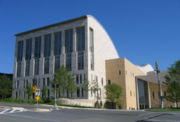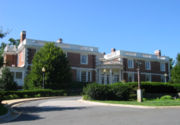
Strathmore (Maryland)
Encyclopedia


North Bethesda, Maryland
North Bethesda is a census-designated place and an unincorporated area in Montgomery County, Maryland, United States. It borders the city of Rockville, and is closely associated with the city.-Geography:...
, USA. Strathmore was founded in 1981 and consists of two venues: the Mansion and the Music Center.
The Strathmore arts complex is connected to an upper floor of the parking garage at the Grosvenor-Strathmore
Grosvenor-Strathmore (Washington Metro)
Grosvenor – Strathmore is a rapid transit station on the Red Line of the Washington Metro in North Bethesda, Maryland...
Washington Metro
Washington Metro
The Washington Metro, commonly called Metro, and unofficially Metrorail, is the rapid transit system in Washington, D.C., United States, and its surrounding suburbs. It is administered by the Washington Metropolitan Area Transit Authority , which also operates Metrobus service under the Metro name...
station via an elevated pedestrian walkway, the Carlton R. Sickles Memorial Sky Bridge, named after late Congressman Carlton R. Sickles
Carlton R. Sickles
Carlton Ralph Sickles was an American lawyer and a Congressman from .Sickles was born in Hamden, Connecticut. After graduating from Georgetown in 1943, Sickles entered the U.S. Army and served until the end of World War II. He returned home to study law and was admitted to the bar in 1948...
. The complex is thus accessible for patrons coming from Washington, D.C.
Washington, D.C.
Washington, D.C., formally the District of Columbia and commonly referred to as Washington, "the District", or simply D.C., is the capital of the United States. On July 16, 1790, the United States Congress approved the creation of a permanent national capital as permitted by the U.S. Constitution....
, as well as the northern part of Montgomery County, Maryland
Montgomery County, Maryland
Montgomery County is a county in the U.S. state of Maryland, situated just to the north of Washington, D.C., and southwest of the city of Baltimore. It is one of the most affluent counties in the United States, and has the highest percentage of residents over 25 years of age who hold post-graduate...
via the Metro rail system.
Background
The center's President & CEO is Eliot Pfanstiehl. More than 5,000 artists and 2 million visitors have attended exhibitions, concerts, teas, educational events and outdoor festivals since 1983.Highlights include hosting the first National Kaleidoscope Exhibition, the world premiere of the Rhodes-Nadler Art Collection, the opening of the 1,976-seat Music Center at Strathmore in February 2005, described as “…the best place to hear an orchestra the Washington area has ever known”; and producing the world premiere concert of "cELLAbration: A Tribute to Ella Jenkins".
Performance and other facilities
- The Mansion at Strathmore is situated on 11 acres (44,515.5 m²) which surround the colonial revivalColonial Revival architectureThe Colonial Revival was a nationalistic architectural style, garden design, and interior design movement in the United States which sought to revive elements of Georgian architecture, part of a broader Colonial Revival Movement in the arts. In the early 1890s Americans began to value their own...
mansion built in 1899 for the Oyster family, and sold to Charles Corby in 1908. The Mansion houses small concerts, art exhibitions, the Strathmore Tea Room, and the Shop at Strathmore. This is the original Strathmore venue and it remained so for almost 25 years.
The Mansion features a 100-seat Dorothy M. and Maurice C. Shapiro Music room. This room hosts the Music in the Mansion series with performances of chamber music, vocal and instrumental recitals, jazz and folk music. There is an 1850 Broadwood piano, restored in 1994. There are free outdoor concerts in summer, as well as hee Backyard Theater for Children every Thursday morning.
The art of Strathmore brings in thousands of visitors each year. There are more than two dozen exhibitions each season from local artists and from collaborations with renowned museums, such as the Baltimore Museum. The Gudelsky Gallery Suite, located at the top of the grand staircase, was named after philanthropists, Homer and Martha Gudelsky. Supported by a donation from the Gudelsky Family Foundation, this gallery features four galleries. It is the only venue of its kind in Montgomery County. There is also a Sculpture Garden that winds through the complex's 11 acres (44,515.5 m²).
The Neo-Georgian
Georgian architecture
Georgian architecture is the name given in most English-speaking countries to the set of architectural styles current between 1720 and 1840. It is eponymous for the first four British monarchs of the House of Hanover—George I of Great Britain, George II of Great Britain, George III of the United...
mansion has columned porticos, Palladian windows and a hilltop setting, the Neo-Georgian mansion is an elegant reflection of the past. Strathmore was designed by Appleton P. Clark, Jr., and constructed in 1902 as a summer home for Captain and Mrs. James Oyster and their family. Beginning in 1908, the Oysters sold the residence and its 99 acres (400,639.1 m²) to Charles I. Corby and his wife, Hattie. It was used as a summer home until 1914 when it was remodeled by architect Charles Keene. After the modifications, the residence became the permanent abode for the Corby family. Mr. Corby died in 1926 after acquiring nearly 400 acres (1.6 km²) of surrounding land and maintaining a fully operational dairy farm and a private golf course. With the death of Mrs. Corby in 1941, the home was purchased by the Sisters of the Holy Cross in 1943 and became known as St. Angela Hall, serving as a convent and school for many years. A local legend persists that from 1941 to 1944, the mansion served as a residence and a temporary governmental headquarters for Manuel L. Quezon
Manuel L. Quezon
Manuel Luis Quezón y Molina served as president of the Commonwealth of the Philippines from 1935 to 1944. He was the first Filipino to head a government of the Philippines...
, President of the Commonwealth of the Philippines. However, there is no firm evidence to support this assertion.
In 1977, the Sisters of the Holy Cross sold the mansion to the American Speech and Hearing Association (ASHA) as a temporary headquarters. In 1979, Montgomery County purchased the property from ASHA for use as an Arts Center. On June 21, 1983, after major restoration of the facility, Strathmore opened its doors to the public.
- The Music Center at Strathmore, which seats 1,976, is a concert hall and education center which opened in February 2005. It was funded by a combination of State of Maryland, Montgomery County and private corporate and local resources to provide a modern concert venue for a wide variety of musical events.
Anchored by the founding partners, Strathmore and the Baltimore Symphony Orchestra
Baltimore Symphony Orchestra
The Baltimore Symphony Orchestra is a professional American symphony orchestra based in Baltimore, Maryland.In September 2007, Maestra Marin Alsop led her inaugural concerts as the Orchestra’s twelfth music director, making her the first woman to head a major American orchestra.The BSO Board...
, resident artistic partners include the National Philharmonic, Washington Performing Arts Society, CityDance Ensemble, Maryland Classic Youth Orchestras, and Levine School of Music.
The venue presents over 150 performances a year and over 75 arts and music education classes each week.
Designed by William Rawn Associates Architects, Inc. of Boston along with Grimm & Parker Architectshttp://www.gparch.com/portfolio.php?PID=28 of Bethesda, MD, acousticians Kirkegaard Associates of Chicago, and Theatre Projects Consultants of South Norwalk, Connecticut, the result is a critically acclaimed venue that Tim Smith from The Baltimore Sun proclaims a, “first class space for music-making.”
Design & Acoustics
The Music Center at Strathmore features an undulating roof that outlines the sloping form of the concert hall. Inspired by the rolling hills of the Strathmore grounds, the 190000 square feet (17,651.6 m²) building is nestled into the an 11 acres (44,515.5 m²) park-like setting.The German limestone façade is punctuated by large glass walls. A six-story, 64 feet (19.5 m) high glass wall in the Lockheed Martin Lobby features 402 panes of glass, and opens to the outdoor Trawick Terrace that overlooks the Strathmore campus.
The concert hall was designed in the traditional “shoebox” form of many international concert halls.
Above the stage, a mechanized canopy of 43 individually controlled acrylic panels can be adjusted to fine-tune sound for clarity and reverberation. Tunable sound-absorbing curtains behind the bronze grilling and banners in the ceiling can be deployed out of sight to dampen or enliven the sound. These acoustical adjustments enable sound technicians to accommodate a wide range of programming—from a solo recital to full symphony orchestra to amplified performances.
The interior finishes of the Concert Hall include 24000 square feet (2,229.7 m²) of maple wood floors, and 19000 square feet (1,765.2 m²) of white birch wall paneling, with red birch details. Custom design details include 700 bronze mesh wall panels, 250 alabaster art glass light fixtures, and maple wood and aubergine velour seats.
The Education Center, located at the opposite end of the building, features four expansive rehearsal spaces, including a dance studio with a sprung floor and two rehearsal rooms with 40 feet (12.2 m) high ceilings. This wing of the building also features a children’s music classroom, a small two-story rehearsal room and nine solo and small group practice spaces.
History
Strathmore, which began as a turn-of-the-century mansion featuring small chamber performances and art exhibitions in 1983, developed its plans for the Music Center over 20 years ago.In 1985, Strathmore’s Board of Directors and President and CEO Eliot Pfanstiehl began discussions about the need for a larger educational and performance space. Approximately 11 years later,
in 1996, the Baltimore Symphony Orchestra, under the leadership of former president John Gidwitz, expressed interest in creating a second home in Montgomery County, and joined Strathmore as a founding partner in a dream for the Music Center at Strathmore. The Music Center at Strathmore plan was led by Montgomery County Executive Douglas M. Duncan and Maryland Governor Parris N. Glendening.
The vision became a reality when, in 1998, the Montgomery County Council and the Maryland State Legislature approved matching capital support ($48 million each) for the Music Center at Strathmore. After the design team was selected in 2001, work began under the direction of the county.
The public-private partnership between Strathmore Hall Foundation, Inc. assumes the day-to-day management and artistic programming of the Music Center and Mansion. Hundreds of generous donors stepped forward to help build, equip and sustain the operation of the Music Center.
- Gudelsky Concert Pavilion and Gazebo, for outdoor performances.
- Outdoor Sculpture Garden.
The grounds contain 23 commissioned and donated sculptures by various local and national artists, including works by Stefan Saal, Barton Rubenstein, Carol Gellner Levin, Foon Sham and Wendy Ross.
New Sculptures
Located on the Bou Family Terrace, "Tetra Con Brio," a monumental sculpture of cast bronze, steel, and polished concrete, stands 12 feet (3.7 m) tall and weighs 4,500 pounds. Created by California artist Roger W. StollerRoger W. Stoller
Roger White Stoller is an American sculptor who specializes in large works integrating bronze and granite. He currently works out of studios in Portola Valley & San Jose, California.- Background :...
, the commissioned work was underwritten by Kenneth and Phillip O’Brien in memory of their father, Ben O’Brien, founder of
Music & Arts Centers.
Suspended above a three-level staircase and spanning 96 feet (29.3 m) of open vertical space by the Discovery Channel foyer, New York artist Meryl Taradash’s "The Music of Light" is composed of shaped acrylic prisms, curved polished aluminum arcs, and reflected light.

